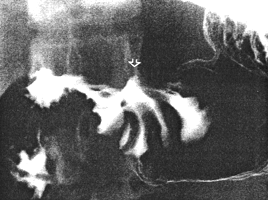



Go to chapter: 1 | 2 | 3 | 4 | 5 | 6 | 7 | 8 | 9 | 10 | 11 | 12 | 13 | 14 | 15 | 16 | 17 | 18 | 19 | 20 | 21 | 22 | 23 | 24 | 25 | 26 | 27 | 28 | 29 | 30 | 31 | 32 | 33 | 34 | 35 | 36 | 37 | 38 | 39
Chapter 29 (page 146)
Case 29.7 A.J., 35 year old female, complained of intermittent epigastric pain and
postprandial nausea of 5 years' duration. Radiographic examination showed an active
ulcer niche on the lower lesser curvature at the commencement of the pyloric sphincteric
cylinder (Fig. 29.7). Prominent oblique mucosal folds were drawn in toward the ulcer;
(they may also be described as radiating fan-like from the ulcer). The sphincteric
cylinder between the ulcer and the pyloric aperture was deformed, filled poorly,
contained prominent oblique mucosal folds, and remained unchanging in appearance with
absent cyclical activity. The mucosal folds remained fixed in the same position, showing
no macroscopic movements. The duodenal bulb filled poorly. Endoscopic biopsy the
same month showed a chronic, active ulcer in the prepyloric region without evidence of
malignancy. The duodenum was normal. The gastric mucosa in the vicinity of the ulcer
showed acute inflammatory cells in the lamina propria with areas of fibrosis and
intestinal metaplasia, diagnosed as acute on chronic gastritis. Anti-ulcer therapy was
commenced; the patient failed to return for follow-up.
 |
Fig. 29.7.
Case A.J. Ulcer (arrow) in sphincteric cylinder, which is deformed. Absent
cyclical activity. Prominent, unchanging, oblique mucosal folds drawn in towards ulcer
|
Case 29.8 L.J., 56 year old female, had a long history of dyspepsia and nocturnal
epigastric pain. Radiographic examination showed a constant contraction of the pyloric
sphincteric cylinder, the contracted region being approximately 2.0cm in length, with
absence of normal cyclical contractile activity (Fig. 29.8). A constant niche on the
greater curvature side of the contracted cylinder indicated an active ulcer. The pyloric
aperture was "fixed" in the open position and rapid emptying of fluid barium occurred.
Anti-ulcer therapy resulted in symptomatic improvement. Endoscopic biopsy a month
later showed two active ulcers in the pyloric region, without macroscopic evidence of
malignancy. Biopsy was difficult on account of narrowing, only fibrino-purulent
material being obtained. Repeat endoscopy after 4 months showed healing of both
ulcers; further endoscopy showed no residual ulceration, narrowing or other abnormality.
 |
Fig. 29.8.
Case L.J. Constant contraction of pyloric sphincteric cylinder (filled arrows). Ulcer in
contracted cylinder (open arrow)
|
The great majority, if not all, cases of chronic, benign ulcers in the pyloric sphincteric
cylinder are associated with contraction of the cylinder. In a recent series of 20
consecutive cases of gastric ulceration within 3.0 to 4.0 cm of the pyloric aperture, we
noted contraction of the cylinder in all. The degree of contraction may vary from
moderate (Fig. 29.5) to severe (Fig. 29.8), and will have a bearing on the radiographic
appearance. Contraction of the cylinder implies diminished or absent cyclical activity of
its musculature (Chap. 13) which, in turn, may delay emptying of solids and hamper
trituration (Chap.18). In some cases contraction is associated with deformity of the
cylinder (Fig. 29.6, 29.7). Cyclical activity is absent in these cases as well.
Normally mucosal folds lie in a circular or spiral direction in the distended pyloric
sphincteric cylinder, changing to longitudinal when the cylinder contracts (Chap. 13).
(This is one of the best examples of co-ordinated movements of the muscularis externa
and mucosa originally described by Forssell) (Chap. 13). As movements of the cylinder
are diminished or absent in cases of local gastric ulceration, it is to be expected that
mucosal fold movements will also be curtailed or absent. In addition some ulcers within
the cylinder are associated with an "indrawing" and fixation of mucosal folds (Fig. 29.6,
29.7), further hampering their movements. It is surmized that the impeded or curtailed
mucosal fold movements seen in cases of gastric ulceration within the cylinder, may
further hamper the processes of expulsion and trituration.
It has been said that the acid-secretory characteristics of pyloric and duodenal ulcers are
similar (Johnson l957, l966; Stadelmann et al. l97l; Brooks l985). The present findings
show that there are important differences between ulcers within the pyloric sphincteric
cylinder on the one hand, and duodenal ulcers (Chap. 30) on the other hand, as far as
motility patterns of the cylinder are concerned.
Previous Page | Table of Contents | Next Page
© Copyright PLiG 1998








